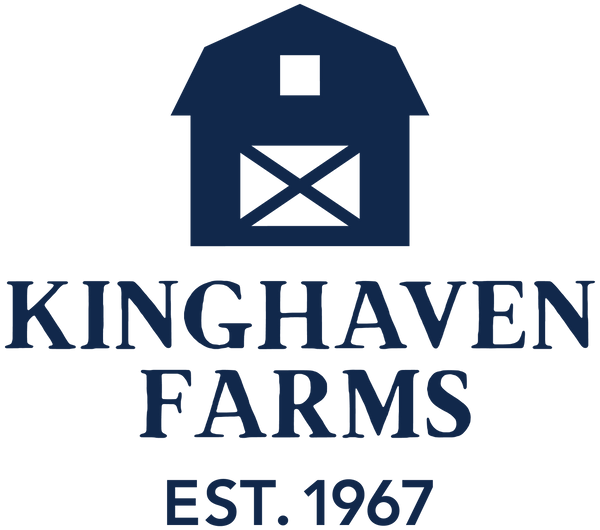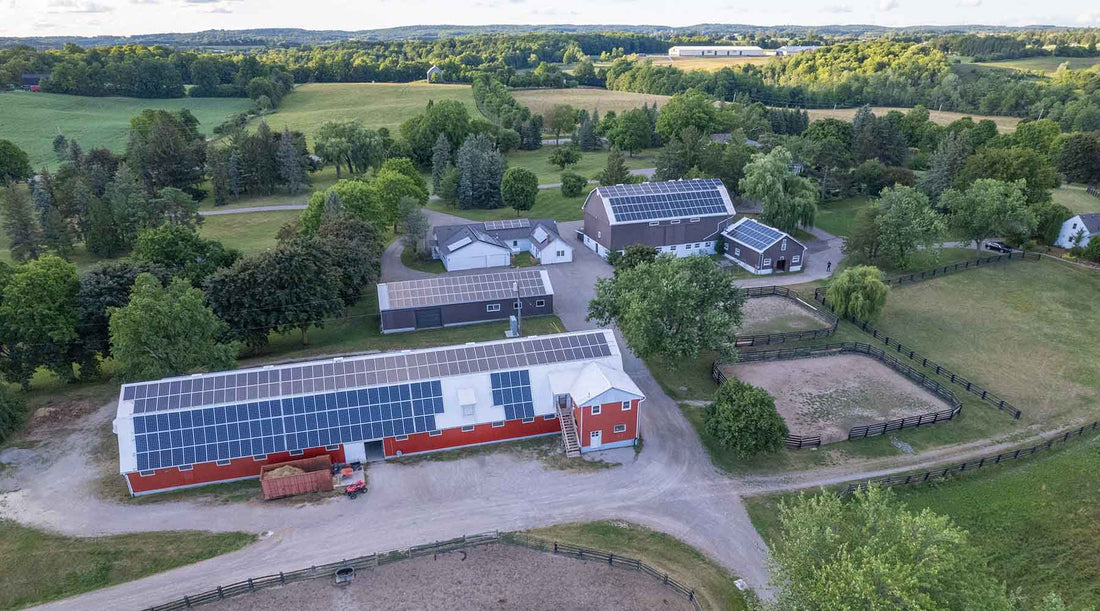April is Earth Month, leading many organizations to launch small-scale green initiatives and trot out their environmental buzzwords. While many have good intentions, implementing real shifts in behaviour is daunting. And only a select few companies are able to enact substantive change — especially when it comes to agriculture.
Traditional farming practices aren’t known for being environmentally friendly. Mass pesticide spraying, soil depletion, and water pollution due to fertilizer runoff are just some of the issues plaguing the industry.
But Kinghaven Farms has always done things a little differently. And when the farm started to transition into territory outside of its traditional purview of horse breeding in the early aughts, the team knew that their adaptation had to come with new environmental directives. This prompted the Willmot family to embark on a series of changes that radically altered their ecological footprint and created ripples beyond their farm boundaries.
How composting came to Kinghaven
As you can imagine, breeding and boarding horses generates a fair amount of waste. For many years, Kinghaven had its horse manure collected by a mushroom grower. But when that partnership ended around a decade ago, there was a rush to develop a new solution, making waste the first issue to tackle during the transition to a more sustainable operation.
The result was basic composting. Water proved to be the biggest part of the initial learning curve. Too much caused rot to set in and the mixture to leach into the ground. Too little, and nothing happened.
Over time, the team hit on the right amount of moisture. And, with turning and adding, the right balance was struck to make the microbes happy. Today, all told, it takes about three years for raw material to make its way through the compost process to become rich, black soil. But the effort is worth it.
Now, the entirety of what comes out of the barns goes into the compost heap, as well as any grass clippings, leaf mulch, and other organic material. And all of the rich, dark topsoil it produces goes back into the earth on the farm, resulting in a closed-loop, waste-free system.
Tree planting for forest renaturalization
The success of the compost project helped provide the impetus to tackle further environmental initiatives on the farm. As a horse farm, much of Kinghaven’s land is divided between paddock and lawn. But as the focus of their operations shifted, the team determined they had underutilized excess paddock space.
Rather than continuing to maintain it, they embarked on a renaturalization project, deciding to return a portion of that space to the woods. About 40 acres of Kinghaven’s 180 acres are forested. To advance the forest line and expand the habitat of local species, the team chose to plant trees next to the natural woodland spaces.
In partnership with a campaign run by the local municipality, King Township, and the Canadian government, Kinghaven Farms planted approximately 2,500 native trees. Flats of silver maples and sugar maples, pine, spruce, hemlock, and cedar saplings were brought in to make the 8-10-acre area as diverse and resilient as possible. Today, the older saplings have shot up to 10-15 feet, while the younger ones stand around shoulder height.
Beyond biodiversity, the aim was to increase the farm’s carbon storage capacity. According to the Arbor Day Foundation, a mature tree siphons 48 lbs of carbon dioxide from the air, exchanging it for oxygen. That means that together, 2,500 trees remove 60 tons of CO2 from the atmosphere.
Balancing woodlot management with ecological processes
While the government partnership was the largest tree-planting project the farm has undertaken (so far), it hasn't been the last. Kinghaven continues to plant trees as part of its woodlot management practices, particularly in areas with fallen, older specimens and aging tree populations.
And their woodlot management practices aren’t confined to tree planting. To safeguard the health of the forest and help maintain the four km of walking trails at the back of the farm, the team practices dead wood removal — although anything live is off limits.
Removing the dead trees also serves to reduce the fuel load. For the city slickers out there, lots of dead, dry wood in a forest means more tinder, or fuel, for burning in case of a forest fire. But, while dry wood is taken, anything rotten is left behind. The aim is not to do too good a job, leaving the forest its natural ability to decompose.
Wildflower fields
Planting trees isn’t the only renaturalization project on the land. As honey producers, Kinghaven Farms is home to a number of bee colonies, and all those buzzing bodies need sustenance. While the land already had a certain amount of natural forage for the bees, the team knew they could do better.
Soil quality isn’t ideal for crops at Kinghaven. It’s never been a wheat or corn farm although there are some apple trees toward the front of the property. But wildflowers grow along the country roads in the area and take to the soil easily. This prompted the team to begin sowing wildflower seeds in a paddock that would otherwise have been used for hay harvest, or lain fallow.
Using native seeds, the team peppered the one-acre space with columbines, butterfly weed, clover, various coneflowers, goldenrod, black eyed susans, asters, yarrow, and lupins. And it worked — the space has turned into a lush meadow, packed with a riot of colours.
While the project was initially meant to support the bees, they aren’t the only ones to benefit from the display. Insects and birds are attracted to the blooms as well, providing food and habitat for these other pollinators that are increasingly under threat.
And, the cover the flowers provide encourages a certain amount of additional biodiversity in the form of rabbits and small rodents. This, in turn, spurs the return of coyotes and birds of prey like hawks, helping to bring a sense of balance to the ecosystem. Over time, the planting will also bring the soil quality back to its more nutrient-dense, natural state.
Perhaps best of all, the bees aren’t confined geographically. The wildflower meadow sustains them, but it also gives them the opportunity to travel further. And pushing them further afield helps to pollinate everything around the farm, including neighbours’ crops.
The flowers have been so successful that the team is intensifying the amount of seed they put down this year. But while they’ll add seeds, the idea is to let nature do its thing as much as possible. This means timing any planting to happen before a rain. It may seem like a small act, but the team places an emphasis on water conservation. And not watering the flowers is just one of a small series of actions that add up to a larger ethos.
Introducing clean landscaping practices
This philosophy of small actions adding up to a larger whole extends to Kinghaven' landscaping. This is often a tricky subject for gardening enthusiasts that value environmentalism, as landscaping and sustainability are often mutually exclusive.
Hopping on a riding mower might conjure up idyllic images of sunny days in the country and the smell of new-mown grass. But gasoline-powered lawn care tools are major emitters of carbon monoxide, nitrogen oxides, fine particulate matter (PM), and carbon dioxide.
In fact, a report out of California shows that these small off-road engines, or SOREs as they’re known, emit more than the entire fleet of 14.4 million cars on the road in America’s most populous state. And because they’re easily inhalable, these emissions cause a number of health risks.
Knowing this while simultaneously maintaining such a large property began to feel like a disconnect, and the team knew they had to start making efforts to cut down on as much of the intensive landscaping as possible.
While the farm still uses some gas-powered landscaping equipment, the intention is to phase it out over time, eventually converting 100% of their lawn maintenance gear to electric.
To that end, the farm decided to invest in four iMOWs, a type of automated lawn mower. Essentially a system of roombas for the outdoors, the iMOWs are scheduled and run on an app, each facilitating between 50-60 hours of cutting a week.
Running these automated mowers has drastically reduced the amount of cutting that needs to be done — both from an emissions and a person-hour perspective. And, while they don’t charge off of the farm’s solar panels (yet), the iMOWs do charge off of the electrical grid which the farm’s solar panels feed into. Beyond the environmental impact, this makes them cheaper to run and very low maintenance since they require neither diesel nor oil.
Solar energy
Although there’s immense value in all of these practices, the crowning jewel in Kinghaven’s environmental operations is the farm’s solar installation. The just over 1,000-panel array at Kinghaven generates 265 kilowatts of electricity — much more electricity than they currently use.
As early adopters of the technology, Kinghaven feeds this power into the electrical grid, helping offset carbon emissions within their larger community. Kinghaven’s passion for sustainability has driven them to expand their solar portfolio to four additional facilities. Together, these sites generate over 2,000 megawatt hours of electricity annually — 6.2 times more than the farm uses.
The final word on sustainable farming
While the team at Kinghaven Farms is making genuine efforts to lessen their environmental footprint, they know they haven’t perfected things — yet. But they’re steadfast in their mission toward sustainable agricultural practices and committed to instigating positive changes every step of the way.
All farm operations are viewed through an ecological lens — where can we cut back, how can we be less resource intensive and reduce our footprint? Ultimately, they know that these small changes — applied intelligently — can turn the tide and make some of the most significant differences. That, and they’ve got some exciting green projects planned too.

